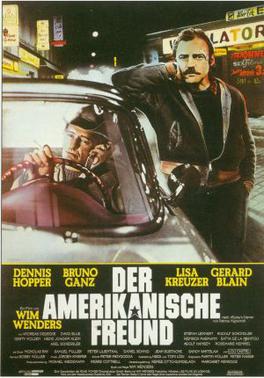The 1977 German film, The American Friend, tells the story of two men.
Tom Ripley (played by Dennis Hopper) is an American. He’s also a very wealthy criminal. He wears a cowboy hat almost everywhere he goes and always tends to be a little bit too forceful when he talks to people. Because he’s wealthy, he is tolerated by high society but everyone seems to view him with a bit of suspicion. And perhaps they should because Ripley actually has a pretty good scheme going. Working with an artist named Derwatt (director Nicholas Ray), Ripley sells forged paintings. He goes to auctions and bids on these paintings, artificially driving up the price. When Ripley isn’t selling forged paintings, he’s traveling around the world and speaking into his tape recorder. He’s an existential cowboy, one who doesn’t appear to have any morals but who is still capable of exclaiming, “I’m confused!” with real anguish in his voice.
Jonathan Zimmerman (Bruno Ganz) is a German art restorer and picture framer who has a beautiful wife, two children, and a lovely shop. He also has leukemia and is obsessed not only with his impending death but also his fear that he’s going to end his life without really doing anything memorable. When Jonathan meets Ripley at an art auction, he refuses to shake Ripley’s hand because he knows about Ripley’s shady reputation. Ripley is offended but slightly forgiving when he learns, from a mutual acquaintance, that Jonathan has been sick.
Back at his mansion, Ripley receives a message from a French gangster named Minot (Gerard Blain). Minot wants Ripley to murder a rival gangster for him. Ripley, however, tells Minot that he should contact Jonathan and offer him the contract. Ripley then spreads a rumor that Jonathan’s illness has gotten worse and that both his doctor and his family are keeping the truth from him. Now believing that he’s on the verge of dying and desperate to make some money so that his family won’t be helpless after he’s gone, Jonathan is far more open to accepting Minot’s unexpected offer to become a hired gun.
To his shock, Jonathan is able to carry out the murder. However, Minot is not content to just have Jonathan kill one man. Minot is concerned about the activities of an American gangster (played by director Sam Fuller) and he expects Jonathan to keep killing for him. Meanwhile, Ripley, feeling a bit conflicted over his part in Jonathan’s new career, take it upon himself to help Jonathan out in his latest assignment. And so, on odd friendship is born….
The American Friend is based on Patricia Highsmith’s novel Ripley’s Game (which, itself, is a sequel to oft-filmed The Talented Mr. Ripley). In Highsmith’s novels, Ripley was always portrayed as being suave, well-spoken, and never suffering from self-doubt. Dennis Hopper plays Ripley as a cowboy who appears to be in the throes of an existential crisis. It’s quite the opposite of the literary Ripley but it works perfectly in the world created by The American Friend. At times, there’s something almost child-like about Hopper’s Ripley. As played by Hopper, Ripley is an unintentional force of destruction, one who targets Jonathan on an impulse and then, just as impulsively, decides to help him out. It’s one of Hopper’s best and most multi-layered performances.
Dennis Hopper is equally matched by the great Bruno Ganz, who plays Jonathan as being a gentle soul who is as shocked as anyone to discover that he’s capable of murder. Though he is morally offended by Ripley’s reputation, he still can’t help but try to help Ripley out when Ripley unexpectedly shows up at his shop. Even towards the end of the film, Jonathan seems to be so happy to finally be doing something unexpected with his life that his joy is almost infectious. You’re happy for him, even though you know things probably won’t turn out well for him.
As directed by Wim Wenders, The American Friend is a perfect mix of existential angst and film noir homage. While there’s undoubtedly a political subtext to the film — one gets the feeling that Ripley’s destructive friendship with Jonathan is meant to represent the way that America views Europe — The American Friend works best as an homage to the glorious B-movies of the 40s and 50s. (It’s probably not a coincidence that both Nicholas Ray and Samuel Fuller have prominent supporting roles.) There’s a sequence on a train that’s the equal to Hitchcock at his best and the story’s conclusion will stick with you long after the film ends.
Sadly, most of the principle members of the cast are no longer with us. All of them are at their best in The American Friend and Wim Wenders gives them all a terrific showcase in which to display their talent. The American Friend is definitely a film worth tracking down.
